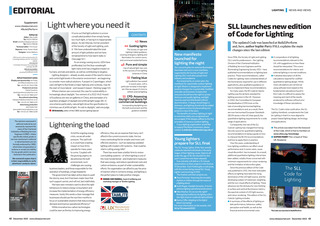


LIGHTING | NEWS AND VIEWS SLL launches new edition of Code for Lighting New manifesto launched for lighting the night Ten core principles for external illumination have been laid out in a new manifesto supported by the Society of Light and Lighting (SLL) and other groups from industry and academia. Accompanied by an action plan, the manifesto for responsible outdoor lighting at night (Rolan) is designed to implement positive changes for a sustainable, healthier and safer environment. It states that everyone should have the right to access darkness and quality lighting, and light must be used and distributed without discrimination. A design should begin in darkness, and lighting should only be added if it supports nocturnal placemaking and protects a view of the stars. The benets of outdoor lighting at night to maximise safety are recognised and encouraged, if the designs adhere to the ve principles of resource outdoor lighting. If your lighting organisation would like to support the Rolan movement, please contact: k.zielinska-dabkowska@pg.edu.pl Young lighters prepare for SLL final The SLL Young Lighter of the Year awards celebrate talented individuals in the early stages of their lighting career. Open to all under the age of 30, the shortlist for this years award has now been released. Four entrants will deliver a 15-minute presentation on their projects in the nal on 15 December. Each nalist gets a cash prize, with the winner being named SLL Young Lighter and receiving 1,000. The nalists and their projects are: Anna Forrester: Improving the circadian rhythms in children through the means of a lighting device Scott Kluger: Daylight harvester: A tool to enhance lighting operational performance Hiba Mazhar: Do we own the night? Reimagining traditional city lighting with a new light recipe to conscate light pollution Kenny Cliffe: Adapting to the digital future (surveying) For more information on the awards, visit bit.ly/SLLawards2022 The updated Code was launched at Build2Perform and, here, author Sophie Parry FSLL explains the main changes since the last edition Since 1936, the Society of Light and Lighting (SLL) and its predecessors the Lighting Division of the Chartered Institution of Building Services Engineers and the Illuminating Engineering Society (IES) have published recommendations on lighting best practice. These recommendations, called Codes for Lighting, have contained details of the illuminances required for use in different applications, plus qualitative guidance on how to implement these recommendations. For many years, the IES Code for Interior Lighting was the de facto standard for lighting provision in the UK. However, in 2002, the Committee for European Standardisation (CEN) took on the task of providing harmonised lighting recommendations and, as a result, there are now harmonised European Standards (BS EN series in the UK) that specify the quantitative lighting requirements for a wide range of applications. Consequently, the role of the SLL Code for Lighting has changed from being the only source for quantitative lighting recommendations to being a guide on how to interpret the BS EN recommendations and how to apply them in practice. Over the years, understanding of how lighting conditions can affect visual performance and, in some cases, cause visual discomfort, has increased. As a result, additional quantitative lighting criteria have been added, notably those concerned with minimum requirements for colour rendering and the limitation of discomfort glare. Since the previous edition of the Code was published in 2012, the most noticeable effects on lighting have been the rising dominance of the LED light source, and the developing subject of melanopic weighting and the non-visual effects of lighting. These advances are the stimulus for new thinking in surface and vertical illuminance metrics, the spectral content of LED light sources, and colour rendering. This edition of the SLL Code for Lighting includes: A summary of the effects of lighting on task performance, behaviour, safety, perception and health, as well as the nancial and environmental costs. A compendium of all lighting recommendations relevant to the UK, with suggestions on how these should be interpreted. This covers recommendations for interior and external lighting in normal conditions. A detailed description of all the calculations required for codied quantitative lighting design. While most calculations are carried out using software tools based on the fundamental calculations found in this Code, it is difcult to assess the meaning and merit of the results produced by software without prior knowledge of these calculations. The SLL Codes sister publication, the SLL Lighting Handbook, complements the Code for Lighting in that it is more aligned to project-based lighting design, technology and applications. This article was taken from the foreword of the Code, which is free to members at www.cibse.org/knowledge SOPHIE PARRY FSLL is head of Trilux UK Akademie The Code was launched at Build2Perform www.cibsejournal.com December 2022 43 CIBSE Dec 22 pp43 News Supp.indd 43 25/11/2022 16:11